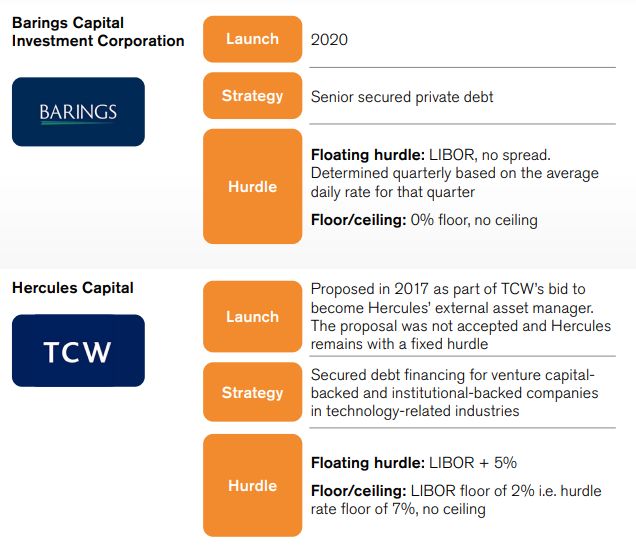In the first article of this two-part series on private debt hurdle rates, we looked at how the recent rise in interest rates has led some private debt investors to view hurdles as "too achievable" and the arguments that can be made both for and against increasing hurdles.
Not many funds have come back to market since interest rates increased drastically, which makes sampling harder, however, whilst so far only a few fund managers have increased hurdles, several have felt pressure from investors to justify maintaining the same waterfall structure given the current market environment.
One of the key concerns of increasing hurdles is that market conditions may change, and managers may be left with hurdles that are too high. This could lead to a misalignment of GP and LP interests which does not benefit either party - a hurdle that is too high may disincentivise GPs or incentivise them to take on excessive risk. For GPs that do not wish to raise their hurdles, this article will explore options to improve alignment and appease investors who wish to see some change to fund terms.
Floating hurdle rates
Floating hurdle rates are not a common feature of private debt funds. However, in recent months they have been increasingly mentioned by both managers and investors as a potential alternative to address interest rate volatility. Typically, hurdle rates in private debt funds have a fixed percentage (e.g. 5%). Given that most private debt funds lend on a floating rate basis, a floating hurdle rate may be better suited to align the GP incentive with the underlying assets.
A floating hurdle rate varies according to a reference rate1 guaranteeing that the manager is not being compensated solely due to a market-wide rise in interest rates. Because the objective is to align performance compensation to underlying instruments, the reference rate used for the hurdle should be consistent with the fund's underlying loans and consider the market/geography and the currency most relevant for the fund's strategy. This implies that determining an appropriate reference rate is more challenging for funds with a greater global focus. A margin, also known as spread, would also typically be added to the reference rate. As with fixed hurdles, floating hurdles can be compounded annually in arrears based on the previous year's average reference rate. The challenge however is in determining the margin over the reference rate.
Different approaches for determining the margin
- Implied historic margin: considering the
period between 2018 and 2022 when UK reference rates were close to
0.6%2, the margin of a direct lending floating hurdle
would have been 4%-4.5% to mirror the fixed hurdle offered at the
time. That same margin today would imply a current hurdle in excess
of 9%, which for direct lending would be considered
excessive.
- Margin based on underlying loans: one possible
approach is to mimic the underlying terms so that if, on average, a
fund expects to lend at reference rate + 5% for example, the hurdle
would be set at reference rate + 3%. However, if reference rates
return to 0.6%, this hurdle could be considered too low.
- Adding a floor: establish a relatively lower
margin over the reference rate and add a floor e.g. reference rate
(floored at 3%) + 2% margin. In this case, the hurdle rate is
floored at 5% and is likely to vary in coming years between 7.5%
and 5% based on ING's forecast for UK interest rates.
- Adding a cap: caps, also known as ceilings, can in theory also be included. However, it is uncommon for lenders to cap interest payments, instead it is usually up to borrowers to manage this risk3. In the context of hurdles, LPs may also not find caps as attractive.
Hurdle rates, often referred to as preferred returns, set the minimum return required before GPs can start sharing in the profits with LPs. In private debt, these are typically "soft" hurdles meaning that the GP receives carry on the entirety of the profits (if the hurdle is met).
Benefits and challenges of floating hurdle rates
|
Benefits |
Challenges |
|
They are more intuitive than fixed hurdles as they match the behaviour of the underlying loans. |
Linking private debt hurdles to interest rates implies a linear relationship between interest rates and fund performance. However, as mentioned in the previous article of this series, this relationship is not linear. Private debt loans are primarily exposed to credit risk, which is expected to continue to increase in the current environment. |
|
They aim to maintain alignment through different market conditions. |
In a high interest rate environment, the floating hurdle will likely only reflect the behaviour of fully performing loans. However, at the fund level, it is expected that during such a period, several portfolio companies will look to amend or restructure their loans and some might experience technical or actual default. Notably, this is not reflected in the floating hurdle. |
|
They can be protective for the GP and for the LP. |
Floating hurdles are not market standard. They can create some additional complexity when calculating the preferred return and when calculating equalisation interest for LPs entering the funds at later closes. |
In practice, there are few examples of private fund managers using
floating hurdle rates. Some examples can be found in business
development companies (BDCs). Notably, Barings has had a floating
hurdle for one of its BDCs since 2020 and TCW suggested in 2017 (a
time when interest rates were rising in the US) that Hercules
Capital should also adopt floating hurdles4. Still, from
publicly available information, private credit BDCs launching in
2023 are still opting for a fixed hurdle.

Click here to continue reading . . .
Footnotes
1. As with underlying debt instruments, potentially relevant reference rates vary by currency and market, and include the following (and rates derived from them): EURIBOR, SOFR and SONIA.
2. Based on yearly averages for SONIA between 2018 and 2022 for simplicity - please note that SONIA-based loans are likely to use SONIA "compounded in arrears" across the relevant interest period of the loan (usually 1M, 3M or 6M).
3. It is often up to the borrower to cap its interest rate risk via linked interest rate derivatives.
4. In 2017, TCW submitted a proposal to Hercules' independent board members to become its external investment advisor. This proposal was not accepted.
The content of this article is intended to provide a general guide to the subject matter. Specialist advice should be sought about your specific circumstances.

